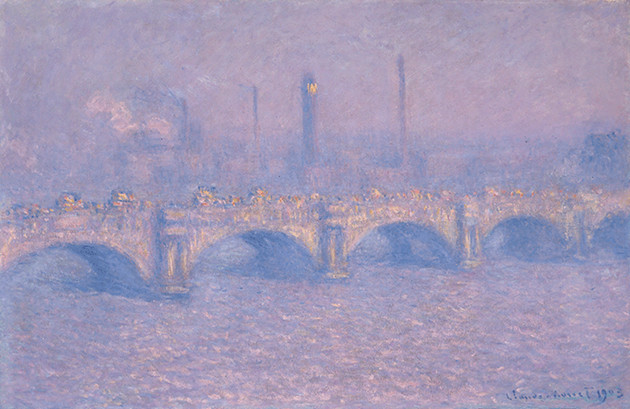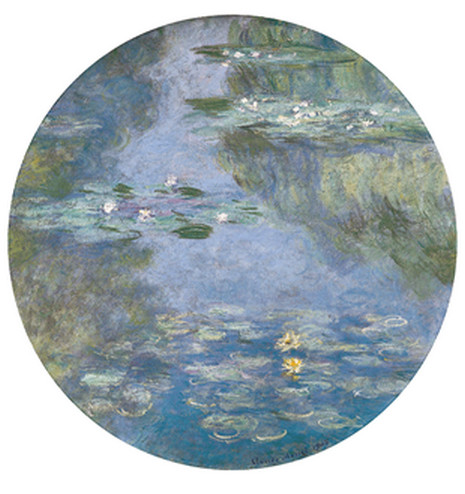Monet
09 Oct 2015 - 10 Jan 2016

Claude Monet, Waterloo Bridge, Veiled sun,1903
oil on canvas, 64,77 x 99,7 cm
Memorial Art Gallery, Rochester
oil on canvas, 64,77 x 99,7 cm
Memorial Art Gallery, Rochester
MONET
Lost in Translation
9 October 2015 – 10 January 2016
With the unique selection of the greatest French Impressionists – totalling about 50 works of which a third are by Monet – ARoS wishes to revitalise Monet and his time by raising questions like: what is the significance of Impressionist art to present-day viewers and why are these works still pertinent today?
In Monet – Lost in Translation, visitors are ushered into the awareness that art is not necessarily what you see at a first glance. What you see initially is the artwork. Meaning, in terms of historical document and aesthetic object, will emerge when the person seeing is willing to make the effort.
LOST APPRECIATION
Monet and his fellow Impressionists are no longer regarded as creators of scandalous art, but as legends whose works have evolved into world-famous icons to be seen everywhere: in art museums and as reproductions on posters, T-shirts, coffee mugs, and calendars. One could rightly claim that Monet and the Impressionist imagery, generally, have become devalued. Precisely because Monet is present in any number of contexts from the most spectacular sales in auction houses all over the world to IKEA furnishing departments, many have lost sight of the age and the perspective from which the work of Monet and his contemporaries sprang. The appreciation of their art and practice has been irretrievably lost. They are now reduced to clichés or iconic brands. They are, as the exhibition title states, ‘Lost in Translation’.
A TRAVEL THROUGH THE GALLERIES
In the first gallery of Monet – Lost in Translation, visitors will experience how the Impressionists travelled by steam train and steamship in order to experience the world afresh. This gallery contains a stage set, therefore, illustrating Paris in the 1880s with aerial photos of the city, streets and lanes, and St. Lazare Railway Station whence the Impressionists would have left the city for the countryside. This, too, is where the visitor begins his/her journey back to the late 1800s.
Contemporary characters with their ever-inquisitive approach, broad outlook and optimistic expectations to the future will be taking us on an artistic tour de force, past the forests of Fontainebleau, fields of wild flowers and haystacks bathed in sunlight, across the beaches on the Atlantic coast to Monet’s garden in Giverny, a journey that also sees the formation of modern man as we know him today. We will see artworks depicting rural scenes, especially in Normandy, along the rivers and the coasts of northern France. As the journey proceeds, we begin to understand how Impressionist landscape painting heralded a new direction in art. We trace the emergence of the Barbizon School of artists and early plein-air painting to mature Impressionism in the form expressed notably by Monet, but also by Renoir, Pissaro, Sisley and others, who, in the 1870s, formed the Impressionist artists’ association.
We’re escorted away from the carriage through three galleries with a classic salon-style of hanging before we are led into a darkened room, The Black Box; quite a sumptuous collection of works showing famous and familiar motifs by Monet; water lilies, haystacks and motifs from the Etrétat coast together with famous bridges in London. Finally, we end up in the dentist’s waiting room. This is where the narrative about Monet begins and ends: from the dental surgery in the building that also housed Monet’s art studio to present-day dental surgeries with Monet-posters adorning their walls.
The exhibition Monet – Lost in Translation does not resemble classic salon style. On the contrary. It appears familiar and strange all at once. Through this alienation, we hope to slightly ruffle the expectations that many visitors will have in respect of Monet. We wish to show an angle that will provide a fresh perspective on his art.
Lost in Translation
9 October 2015 – 10 January 2016
With the unique selection of the greatest French Impressionists – totalling about 50 works of which a third are by Monet – ARoS wishes to revitalise Monet and his time by raising questions like: what is the significance of Impressionist art to present-day viewers and why are these works still pertinent today?
In Monet – Lost in Translation, visitors are ushered into the awareness that art is not necessarily what you see at a first glance. What you see initially is the artwork. Meaning, in terms of historical document and aesthetic object, will emerge when the person seeing is willing to make the effort.
LOST APPRECIATION
Monet and his fellow Impressionists are no longer regarded as creators of scandalous art, but as legends whose works have evolved into world-famous icons to be seen everywhere: in art museums and as reproductions on posters, T-shirts, coffee mugs, and calendars. One could rightly claim that Monet and the Impressionist imagery, generally, have become devalued. Precisely because Monet is present in any number of contexts from the most spectacular sales in auction houses all over the world to IKEA furnishing departments, many have lost sight of the age and the perspective from which the work of Monet and his contemporaries sprang. The appreciation of their art and practice has been irretrievably lost. They are now reduced to clichés or iconic brands. They are, as the exhibition title states, ‘Lost in Translation’.
A TRAVEL THROUGH THE GALLERIES
In the first gallery of Monet – Lost in Translation, visitors will experience how the Impressionists travelled by steam train and steamship in order to experience the world afresh. This gallery contains a stage set, therefore, illustrating Paris in the 1880s with aerial photos of the city, streets and lanes, and St. Lazare Railway Station whence the Impressionists would have left the city for the countryside. This, too, is where the visitor begins his/her journey back to the late 1800s.
Contemporary characters with their ever-inquisitive approach, broad outlook and optimistic expectations to the future will be taking us on an artistic tour de force, past the forests of Fontainebleau, fields of wild flowers and haystacks bathed in sunlight, across the beaches on the Atlantic coast to Monet’s garden in Giverny, a journey that also sees the formation of modern man as we know him today. We will see artworks depicting rural scenes, especially in Normandy, along the rivers and the coasts of northern France. As the journey proceeds, we begin to understand how Impressionist landscape painting heralded a new direction in art. We trace the emergence of the Barbizon School of artists and early plein-air painting to mature Impressionism in the form expressed notably by Monet, but also by Renoir, Pissaro, Sisley and others, who, in the 1870s, formed the Impressionist artists’ association.
We’re escorted away from the carriage through three galleries with a classic salon-style of hanging before we are led into a darkened room, The Black Box; quite a sumptuous collection of works showing famous and familiar motifs by Monet; water lilies, haystacks and motifs from the Etrétat coast together with famous bridges in London. Finally, we end up in the dentist’s waiting room. This is where the narrative about Monet begins and ends: from the dental surgery in the building that also housed Monet’s art studio to present-day dental surgeries with Monet-posters adorning their walls.
The exhibition Monet – Lost in Translation does not resemble classic salon style. On the contrary. It appears familiar and strange all at once. Through this alienation, we hope to slightly ruffle the expectations that many visitors will have in respect of Monet. We wish to show an angle that will provide a fresh perspective on his art.

